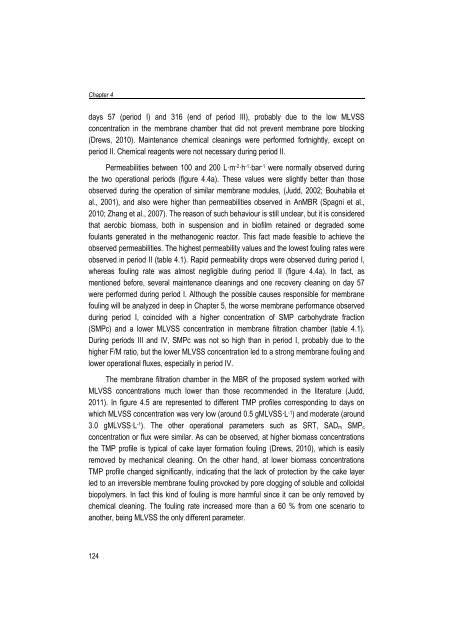Combining submerged membrane technology with anaerobic and ...
Combining submerged membrane technology with anaerobic and ...
Combining submerged membrane technology with anaerobic and ...
You also want an ePaper? Increase the reach of your titles
YUMPU automatically turns print PDFs into web optimized ePapers that Google loves.
Chapter 4days 57 (period I) <strong>and</strong> 316 (end of period III), probably due to the low MLVSSconcentration in the <strong>membrane</strong> chamber that did not prevent <strong>membrane</strong> pore blocking(Drews, 2010). Maintenance chemical cleanings were performed fortnightly, except onperiod II. Chemical reagents were not necessary during period II.Permeabilities between 100 <strong>and</strong> 200 L·m -2·h -1·bar -1 were normally observed duringthe two operational periods (figure 4.4a). These values were slightly better than thoseobserved during the operation of similar <strong>membrane</strong> modules, (Judd, 2002; Bouhabila etal., 2001), <strong>and</strong> also were higher than permeabilities observed in AnMBR (Spagni et al.,2010; Zhang et al., 2007). The reason of such behaviour is still unclear, but it is consideredthat aerobic biomass, both in suspension <strong>and</strong> in biofilm retained or degraded somefoulants generated in the methanogenic reactor. This fact made feasible to achieve theobserved permeabilities. The highest permeability values <strong>and</strong> the lowest fouling rates wereobserved in period II (table 4.1). Rapid permeability drops were observed during period I,whereas fouling rate was almost negligible during period II (figure 4.4a). In fact, asmentioned before, several maintenance cleanings <strong>and</strong> one recovery cleaning on day 57were performed during period I. Although the possible causes responsible for <strong>membrane</strong>fouling will be analyzed in deep in Chapter 5, the worse <strong>membrane</strong> performance observedduring period I, coincided <strong>with</strong> a higher concentration of SMP carbohydrate fraction(SMPc) <strong>and</strong> a lower MLVSS concentration in <strong>membrane</strong> filtration chamber (table 4.1).During periods III <strong>and</strong> IV, SMPc was not so high than in period I, probably due to thehigher F/M ratio, but the lower MLVSS concentration led to a strong <strong>membrane</strong> fouling <strong>and</strong>lower operational fluxes, especially in period IV.The <strong>membrane</strong> filtration chamber in the MBR of the proposed system worked <strong>with</strong>MLVSS concentrations much lower than those recommended in the literature (Judd,2011). In figure 4.5 are represented to different TMP profiles corresponding to days onwhich MLVSS concentration was very low (around 0.5 gMLVSS·L -1 ) <strong>and</strong> moderate (around3.0 gMLVSS·L -1 ). The other operational parameters such as SRT, SAD m SMP cconcentration or flux were similar. As can be observed, at higher biomass concentrationsthe TMP profile is typical of cake layer formation fouling (Drews, 2010), which is easilyremoved by mechanical cleaning. On the other h<strong>and</strong>, at lower biomass concentrationsTMP profile changed significantly, indicating that the lack of protection by the cake layerled to an irreversible <strong>membrane</strong> fouling provoked by pore clogging of soluble <strong>and</strong> colloidalbiopolymers. In fact this kind of fouling is more harmful since it can be only removed bychemical cleaning. The fouling rate increased more than a 60 % from one scenario toanother, being MLVSS the only different parameter.124
















